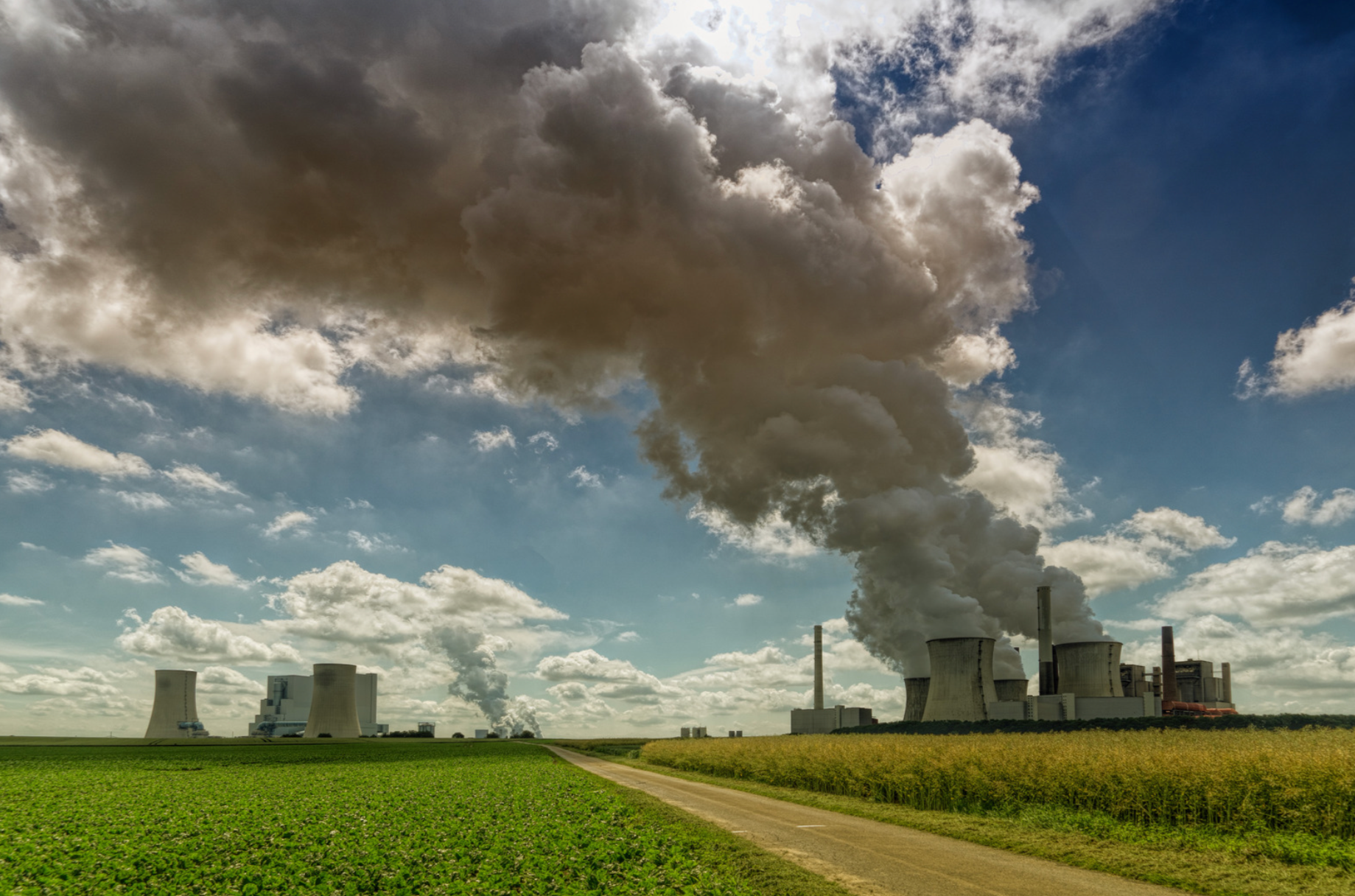Senergy Builders Blog

When we talk about fighting climate change, most people think about things like switching to electric cars, installing solar panels , or flying less. Those are all important, and correct, but there’s a huge piece of the emissions puzzle that often gets overlooked: industry. We’re talking about the stuff that literally builds the world around us– steel, cement, chemicals, glass, and more. These are the foundations of everything from roads to smartphones. But here’s the kicker: industrial processes are responsible for about a quarter of the world’s greenhouse gas emissions. That’s massive. And unlike switching your car or your light bulbs, decarbonizing industry is complicated. It’s messy. The technologies exist, but they’re often expensive or inconvenient– especially for the people and companies with the most power to implement them. Still, transforming industry is absolutely essential– and I’m here to unpack why it’s hard, what’s changing, and how we can push for solutions that actually make a difference. Why Is Industry So Tough to Decarbonize? Let’s start with the honest truth: cutting emissions from industry is way harder than cleaning up something like the electricity sector. Here's why: Some emissions are baked into the process For example, when you make cement, you heat up limestone, and that chemical reaction releases carbon dioxide. It’s not just about the fuel used, it’s the reaction itself. So even if you're using clean energy, you still get CO2 emissions. You need crazy-high heat Things like steel and glass need temperatures that soar above 1,500°C. That’s not easy to achieve with electricity (at least not yet), so most places still burn coal or gas. Factories aren’t easy to change overnight Industrial plants are huge investments. They’re built to last decades, and they don’t get upgraded often. That means any big changes are risky, expensive, and need serious planning. But here’s the good news: change is finally starting to happen. What Can We Do About It? Even though the challenges are big, there are already a bunch of exciting solutions out there. Some are being tested in real factories today. Here are some of the most promising approaches: Use Less Energy (and Waste Less) Before we reinvent the wheel, let’s make the current systems more efficient. Think better insulation, heat recovery systems, or smarter control systems that waste less energy. These are low-hanging fruit, and they often pay for themselves. Switch to Electric Where Possible Electrifying industrial equipment means you can tap into renewable electricity. For some things, like low-temperature drying or electric arc furnaces for recycling steel, it’s already doable. High-heat processes are tougher, but technology is improving fast. Bring in Green Hydrogen Hydrogen can burn hot like fossil fuels, but when it’s made with clean electricity (we call it "green hydrogen"), it doesn’t release CO2. This is a game-changer for heavy industry. For example, instead of using coal to make steel, some companies are testing hydrogen as a clean alternative. Capture the Carbon We Can’t Avoid Carbon capture, utilization, and storage (CCUS) sounds like science fiction, but it’s very real. These systems trap CO2 from factories and either store it underground or turn it into something useful. It’s not cheap, but it’s one of the only ways to deal with unavoidable emissions, like those from cement. Rethink the Materials We can also lower emissions by reimagining what we use and how we use it. Some startups are making low-carbon or even carbon-negative cement. Others are finding ways to recycle chemicals and plastics more effectively. Innovation in materials science is moving fast.

Let’s be honest, the construction industry has historically had a pretty heavy footprint. Between energy use, material waste, and carbon emissions, traditional building practices have contributed significantly to environmental degradation. We started Senergy Builders because we knew there was a better way to do this work. One that respects natural resources, prioritizes energy efficiency, and takes long-term environmental impact seriously. Sustainability isn’t just a box we check. It's part of every conversation we have, every design we draft, and every material we choose. At Senergy Builders, every day is a chance to build something meaningful. When we say this, we’re not just talking about structures, but a future that’s more sustainable, more thoughtful, and more in balance with the planet we all share. But on Earth Day, we take a moment to pause, reflect, and talk about why our work goes beyond construction. It’s about responsibility, resilience, and protecting the Earth for the generations to come. How We’re Reducing Impact Through Smarter Building Sustainable building comes with consistency, resilience, and dedication. All for the betterment of the planet, starting with our home of Grand Junction. For us, it means using practical, proven strategies that reduce a home or building’s environmental impact, during construction and long after the keys are handed over. Here’s a look at what that actually means on the ground: Energy Efficient Design From passive solar layouts to high-performance insulation and energy modeling, we design buildings that require significantly less energy to heat, cool, and power. Renewable Energy Integration We regularly install solar systems and prepare homes for future clean energy upgrades. Sustainable Materials Whenever possible, we source responsibly harvested wood, reclaimed materials, and non-toxic finishes that are better for the environment and for the people living or working in the space. Waste Reduction on Site Construction can be messy, but we work hard to minimize waste and recycle materials during and after the build. Durability and Longevity A truly sustainable building isn’t just efficient, it’s built to last. The longer a structure holds up, the less often it needs to be replaced or renovated. Earth Day And Every Day Earth Day is a reminder, but this is year-round work. This day is important as it shines a spotlight on the planet and the choices we make. But for us, environmental responsibility isn’t a one-day event. It’s baked into our everyday practices, our partnerships, and our long-term goals. We’re constantly asking ourselves how we can improve: What materials are emerging that have a lower environmental cost? How can we make high-efficiency homes more accessible to more people? What kind of legacy are we leaving behind with each build? We don’t have all the answers, but we’re committed to the process, and that starts with asking the right questions.

We’ve all heard about the importance of protecting the environment and reducing our carbon footprints. But let’s be honest, when it comes to making eco-friendly choices, most of us don’t always think about how it affects our daily lives. We’re busy, and sometimes the thought of “saving the planet” feels a bit far removed from our personal comfort. But here’s the thing: we’re here to tell you that energy efficient homes aren’t just good for the environment - they’re also great for your comfort. Let’s Talk About the Environment First Okay, let’s start with the obvious: energy efficient homes help the environment. It’s like a win-win for the planet. Homes consume a lot of energy - think heating, cooling, lighting, and powering your favorite gadgets. All that energy comes from somewhere, and too often, it’s from non-renewable sources like coal or gas, which release harmful emissions into the atmosphere. This contributes to global warming and climate change. Energy efficient homes reduce this impact. Thanks to better insulation, energy efficient windows, and more sustainable appliances, these homes use less energy and lower the demand for fossil fuels. It’s like your home becomes a little eco-warrior, cutting back on waste and pollution. And hey, the U.S. Environmental Protection Agency says if everyone made their homes more energy efficient, we could cut energy use by 20% and reduce harmful emissions by a ton. That’s where we can make a difference. But we all know that life happens, and the planet’s future isn’t the only thing on our minds. Let’s talk about the perks of energy efficient homes for you, the person actually living in one. Temperature Control and Comfort All Year Round Anyone who’s ever battled with a wonky thermostat knows how frustrating it can be to keep a consistent temperature in your home. In the winter, you’re bundled up under blankets, waiting for the heat to kick in, and in summer, you’re cranking the AC to survive the heatwave. And even then, it’s never quite right, right? Enter energy efficient homes. These homes are designed to keep the temperature just right. Good insulation means your house can hold onto the warmth in the winter and the cool air in the summer, so you’re not constantly adjusting the thermostat or dealing with cold drafts. Instead of feeling like you’re living in a sauna or an icebox, your home stays comfortable no matter what the weather is doing outside. What’s even better? Advanced heating and cooling systems like geothermal heat pumps or smart thermostats take comfort to the next level. These systems use the earth’s temperature or learn your schedule to adjust things automatically, so you always come home to a cozy house. It’s like your home is working with you, not against you, to keep things comfy. Fresh Air and Better Breathing

There’s something magical about this time of year. The Spring Equinox has arrived, and with it comes a perfect balance of day and night. It’s that glorious moment when we officially say goodbye to winter and hello to longer days, warmer weather, and all things fresh and new. As we celebrate this season of growth, rebirth, and renewal, we can’t help but think about how perfectly it aligns with the idea of building a better future - and that’s exactly what we’re all about here at Senergy Builders. So, why is the Spring Equinox a big deal for us? Well, just like how nature is waking up, it’s the ideal time to start thinking about how we can transform our homes into something more sustainable and energy efficient. In the spirit of the season, we’re all about new beginnings. Whether that’s planting new flowers in your garden or planting the seeds for a more eco-friendly home, the changes you make today can make a world of difference tomorrow. With the days getting longer and the sun shining brighter, there’s no better time to talk about how energy efficient homes are in perfect harmony with the season. The Season of New Beginnings Spring represents a time of renewal and fresh starts. Flowers bloom, trees bud, and the world feels alive again. After a long winter, it’s a time to refresh, rejuvenate, and rethink things. And we think your home should be no different! Why not bring that same energy to your living space by investing in a home that’s not only beautiful but also energy efficient? Now more than ever, consider how investing in an energy efficient home can help align your lifestyle with the rhythms of the season. With warmer weather around the corner, an energy efficient home ensures that you’ll enjoy a comfortable, sustainable living environment all year long. An energy efficient home is a perfect way to align your living space with the natural rhythms of the season. Just like you feel lighter and brighter when the weather warms up, an energy efficient home helps create a more comfortable and sustainable environment to live in. Think about it: If your home is energy efficient, it works with the natural world around it - keeping you cozy when the weather is a little chilly and cool when the temperatures rise, all without overworking your heating or cooling systems. The Power of Nature Spring is all about appreciating the power of nature. We’ve got longer days, more sunlight, and warmer weather - which means it's the perfect time to embrace energy efficient features that can help your home function more in tune with the outdoors. One of the best ways to do this is by making the most of natural light. Installing energy efficient windows, for instance, can let in more light without sacrificing insulation. You’ll get the benefits of sunlight without worrying about your energy bills going up. Plus, did you know that the more natural light you have in your home, the better your mood tends to be? It’s like a little sunshine boost for your spirits, all while saving energy. If you’re thinking about making a bigger change, solar panels are another great way to harness nature’s power. They’re a fantastic way to make use of all that wonderful sunshine, turning it into energy for your home - and reducing your carbon footprint at the same time. It’s like having a little piece of spring energy captured and stored right on your roof. And let's not forget about passive solar heating, which uses the sun’s warmth to naturally heat your home. In the spring, that means your home can stay comfy without needing to crank up the heat. Imagine a home that works with the weather, not against it. A win for your comfort, and a win for the environment.

Understanding Ocean Warming If you’ve ever taken a walk along the beach or dipped your toes in the ocean, you know that the sea is more than just water. It’s alive, dynamic, and deeply tied to the health of our planet. We’ve often heard the ocean described as the “heartbeat of Earth,” and for good reason – it regulates the climate, supports countless species, and provides food and livelihoods for millions of people. But, as we know, things aren’t exactly smooth sailing right now. The ocean is changing, and ocean warming is one of the most alarming signs of that change. What Is Ocean Warming? Ocean warming refers to the rise in ocean temperatures, a direct result of climate change and the increased amount of greenhouse gases in our atmosphere. Essentially, as we burn fossil fuels and release carbon dioxide (CO2), more heat gets trapped in the atmosphere. The ocean, being a massive heat sink, absorbs around 90% of this excess heat. As a result, the temperature of our oceans has been rising steadily. Now, you might be thinking 0.13°C per decade doesn’t sound like much. But in reality, this seemingly small increase has big impacts. It’s enough to mess with marine ecosystems, change weather patterns, and threaten coastal communities. The scariest part? Some parts of the ocean, like the Arctic, are warming much faster than others. The Impact On Marine Ecosystems Marine species are incredibly sensitive to temperature changes. Just like we have our preferred temperature for a comfy day on the couch, marine creatures have their own preference for thriving. When the ocean gets too warm, it disrupts everything – from coral reefs to fish populations. As ocean temperatures rise, species that are unable to adapt or migrate to cooler waters face the threat of extinction. Take coral reefs, for example. These underwater marvels, which are home to thousands of species, are super sensitive to temperature. When water gets too warm, the corals expel the algae living within them, causing a phenomenon called coral bleaching. Without the algae, corals lose their color, and their survival becomes uncertain. If the bleaching persists, the entire reef can die off, taking down the entire ecosystem with it. This has a ripple effect, endangering not only marine life but also the millions of people who rely on these ecosystems for food and income. Other marine species, such as fish, shellfish, and marine mammals, are also affected by rising ocean temperatures. For example, important fish species like cod and tuna are migrating to cooler waters, impacting fishing industries in regions that once depended on these resources. In addition, the loss of habitat for species such as seals, sea turtles, and whales threatens their survival. Disrupting Ocean Currents and Weather Patterns

Enough is enough. As we witness nature’s fury unfolding in real time, it is impossible to continue to ignore the devastating impact of climate change. The wildfires ravaging California are a glaring example of how the world’s climate is shifting, bringing with it extreme weather events that disrupt ecosystems, threaten communities, and challenge our way of life. The situation has never been clearer. If we want future generations to thrive, we must take urgent, decisive action now. Current Crisis in California California has long been prone to wildfires due to its dry climate and hot summers. However, in recent years, the intensity and frequency of these fires have escalated dramatically. These fires, which are exacerbated by drought, heatwaves, and shifting weather patterns, are becoming more dangerous every year. The fires have not only ravaged large swaths of land but have also impacted air quality, public health, and local economies. It’s not a matter of the fire itself, but smoke from the fires has also blanketed vast areas of the West Coast, creating dangerous conditions for people with respiratory issues and straining healthcare systems already stretched thin by the ongoing pandemic. The consequences of these fires are not limited to the immediate destruction. They ripple through communities, displacing thousands of people and causing long-term environmental damage. The Role of Climate Change So, why are the wildfires getting worse? Climate change is playing a central role. Rising global temperatures, fueled by the burning of fossil fuels and deforestation, are creating conditions ripe for wildfires. Warmer temperatures lead to more severe droughts, which in turn create dry vegetation that acts as fuel for fires. On top of it all, the changing climate alters precipitation patterns, resulting in more intense storms and longer periods of heat, both of which further contribute to fire risk. Scientists have been warning about the potential consequences of unchecked climate change for decades, and now these predictions are manifesting before our very eyes. The reality of a warming planet is no longer a distant concern but a present-day crisis. As the climate continues to warm, we can expect more frequent and more severe wildfires, along with a host of other environmental challenges such as rising sea levels, extreme heatwaves, and more unpredictable weather patterns. The Urgency for Change These wildfires are just one example of the extreme weather events becoming more commonplace due to climate change. They highlight a crucial point, that the need for urgent action is more pressing than ever. If we want to ensure that future generations have a livable planet, we must take meaningful steps to mitigate the effects of climate change and work toward a sustainable future. What can we do?

In an unusual turn of weather, the southern United States has experienced a historic snowstorm that has served as a wake up call for where our earth is headed. These states, typically known for their warm, temperate climates, are now dealing with several inches of snow-covered roads, power outages, and disrupted travel. While snow in the South is not unheard of, it’s certainly a rare event, and it’s putting many residents and local governments to the test. In the midst of this unusual weather event, there’s a growing conversation surrounding energy efficiency, sustainability, and resilience in the built environment. At Senergy Builders , we aim to focus more specifically on energy efficient construction, and how that can play a crucial role in the region’s movement toward sustainability. As climate patterns become increasingly unpredictable, it’s clear that the need for resilient, energy efficient homes and commercial buildings is not just a trend but a lifestyle. All About Energy Efficient Construction Energy efficient construction is a design and building approach that focuses on reducing energy consumption, improving indoor comfort, and minimizing the environmental impact of buildings. Key elements of energy efficient construction include: High-Quality Insulation Proper insulation helps keep heat inside a home or building during winter and outside during summer. By ensuring that buildings are well insulated, energy efficient construction prevents heat loss and reduces the need for constant heating or cooling, ultimately saving energy and lowering utility bills. Energy Efficient Windows Windows account for a significant amount of heat loss in most buildings. Energy efficient windows are designed to minimize this loss by using multiple panes of glass and insulating materials to improve thermal performance. Smart HVAC Systems Heating, ventilation, and air conditioning (HVAC) systems are often among the largest energy consumers in a building. Energy efficient HVAC systems are designed to use less energy while maintaining a comfortable temperature. This is often achieved through advanced controls, better sealing, and more efficient heating and cooling units. Renewable Energy Integration Solar panels, wind turbines, and other forms of renewable energy are being integrated into new construction projects, helping to offset energy consumption from traditional sources. In regions like the South, where the sun shines most of the year, solar power can be particularly effective in reducing dependence on the grid. Water Conservation Features Energy efficient construction also goes hand in hand with water conservation. Low-flow plumbing fixtures, drought-resistant landscaping, and rainwater harvesting systems reduce water waste and help conserve one of the planet’s most precious resources. How This May Help in Snowstorms and Extreme Weather

Wildfires on the West Coast, and particularly in the Los Angeles area, have become an increasingly common and devastating reality. These wildfires, which seem to grow in frequency and intensity each year, highlight the urgent need for a major shift in how we approach our relationship with the environment. With climate change exacerbating the problem, it’s clear that the path to a more sustainable future isn’t just a matter of environmental conservation—it’s essential to our survival. As we witness the destructive force of these wildfires, it’s more important than ever to focus on sustainability in all facets of our lives, especially in the construction industry. At Senergy Builders , we are boldly committed to both energy efficiency and sustainability. We are dedicated to building homes that not only stand stronger against wildfires but also minimize environmental impact. Our vision is to build for the future, reducing carbon footprints through energy efficient construction practices while integrating renewable energy systems, such as solar panels and energy storage solutions. Wildfires in Los Angeles and Construction Practices Los Angeles, known for its sprawling landscapes and beautiful weather, is also a city that has long grappled with the dangers of wildfires. In recent years, however, the scale and devastation of these fires have escalated, pushing many communities to the brink. We’re still watching in real time, an entire community disappearing up in flames to the likes of which we’ve never seen before. It is estimated that a total of 16,100 structures, including homes and businesses have been destroyed by the Palisades Fire and Eaton Fire, which started earlier this month. The reasons for this alarming rise in wildfire activity are multifaceted. On one hand, climate change is contributing to drier conditions, hotter temperatures, and more volatile weather patterns. On the other hand, urban sprawl and increased construction in fire-prone areas have made it more difficult to control and contain these fires. And then, there’s the human element—poor land management practices, urban development, and inadequate building codes that fail to prioritize fire safety all compound the issue. In the face of this growing crisis , the need for more sustainable construction practices becomes glaringly clear. If we’re to mitigate the impact of wildfires and build resilient communities, we must rethink how we approach development and infrastructure. The Key to Preventing Future Disasters Sustainability is no longer a buzzword—it’s a necessity. The growing environmental crises, including wildfires, flooding, and rising temperatures, demand that we evolve the way we live and build. With these disasters getting closer and closer to home each year, it is essential that we start to adapt and minimize the impact in our communities. For us at Senergy, sustainability in construction is the answer, and it involves designing and constructing buildings that are energy-efficient, environmentally friendly, and capable of withstanding the challenges of a changing climate. Energy efficiency is central to the conversation. The way we power our homes, offices, and public spaces must change. The construction of energy efficient buildings—through better insulation, smart windows, and energy efficient HVAC systems — can dramatically reduce our dependence on fossil fuels and, consequently, our contribution to climate change. These buildings not only consume less energy but also produce fewer greenhouse gases, making them a critical component of a more sustainable, fire-safe future.

A home energy audit serves as a vital tool for homeowners seeking to optimize their energy consumption. This process not only identifies areas for improvement but also contributes to significant cost savings and enhances the overall comfort of living spaces. At Senergy Builders , one of our main directives is to promote sustainability in our home of the Western Slope. Let us help you explore the components of a home energy audit as well as the benefits of an energy efficient home with our company. Understanding Home Energy Audits A home energy audit is a comprehensive evaluation of a residential property's energy use. The primary aim is to pinpoint inefficiencies that may be leading to excessive energy consumption and elevated utility bills. Auditors assess various components, including insulation, heating and cooling systems, appliances, windows, and doors, to provide a holistic view of the home's energy performance. Importance of Energy Efficiency Energy efficient homes are designed to consume less energy while maintaining comfort and functionality. This not only translates into lower utility bills but also reduces the home's carbon footprint, contributing to environmental sustainability. In a world grappling with climate change, the shift towards energy efficiency is paramount. The U.S. Department of Energy (DOE) reports that buildings account for a significant portion of total energy use, making residential energy efficiency a crucial component in mitigating environmental impacts. Rating Systems for Energy Efficiency Home energy audits often culminate in a rating system that quantifies the energy efficiency of a home. Various programs exist, such as the Home Energy Rating System (HERS) and ENERGY STAR certification, to assess and endorse energy efficient homes. Home Energy Rating System (HERS) The HERS Index is a scoring system that ranges from 0 to 150, where a score of 100 represents the energy use of a standard new home. A lower score indicates better energy efficiency. Homes that achieve a score of 60 or below are considered highly efficient and may qualify for incentives, such as tax credits or rebates. The HERS Index serves as a reliable benchmark for homeowners, real estate professionals, and builders to evaluate energy performance. ENERGY STAR Certification ENERGY STAR is a program launched by the EPA that identifies energy efficient products and homes. To earn the ENERGY STAR label, a home must undergo rigorous testing to ensure it meets specific energy performance standards. This certification not only signifies that a home is energy-efficient but also often results in lower utility costs and increased property value. The Home Energy Audit Process Conducting a home energy audit involves several steps, typically carried out by a certified energy auditor. This process can vary in complexity but generally includes the following phases: Initial Assessment The audit begins with a walkthrough of the home. The auditor collects information about the home’s size, layout, and existing systems. Homeowners are often asked to provide details regarding their energy bills and any specific concerns they may have about their energy consumption. Blower Door Test One of the critical components of the audit is the blower door test. This test measures the home’s air leakage by pressurizing the house and identifying areas where air escapes. High levels of air leakage can lead to inefficient heating and cooling, making it essential to address these leaks. Insulation Evaluation The auditor inspects the insulation levels in the attic, walls, and floors. Insufficient insulation can result in significant heat loss in winter and heat gain in summer, leading to increased energy consumption. Heating and Cooling Systems The audit includes an examination of the heating and cooling systems to ensure they are functioning efficiently. The auditor may check for proper sizing, maintenance, and overall performance of these systems. Appliance Assessment The energy efficiency of appliances is evaluated during the audit. This includes checking the efficiency ratings of refrigerators, washers, dryers, and other household devices. Older appliances often consume more energy, and recommendations for upgrades may be provided. Recommendations and Report Following the assessment, the auditor compiles a detailed report that outlines the findings, including areas of concern and recommendations for improvements. These may include upgrades to insulation, sealing air leaks, replacing inefficient appliances, or investing in renewable energy sources.

In an time where environmental consciousness has moved to the forefront of consumer priorities, Energy Star has emerged as a key player in promoting energy efficiency and sustainability. Established in the United States of America, Energy Star serves as a trusted label that helps consumers and businesses identify products that meet stringent energy efficiency guidelines. At Senergy Builders , we proudly ensure that all of our homes reach Energy Star standards. But what exactly is Energy Star, who is behind it, and how does it contribute to a more sustainable future? In this blog post, we’ll explore the origins, mission, and impact of Energy Star, and how you can incorporate energy efficient choices into your own life. What is Energy Star? Energy Star is a voluntary program that was launched by the U.S. Environmental Protection Agency (EPA) in 1992. The program’s primary goal is to reduce greenhouse gas emissions and promote energy efficiency through the use of certified products. Energy Star labels can be found on a wide variety of products, including appliances, lighting, heating and cooling systems, and even entire buildings. The Energy Star label is not just a badge of honor; it signifies that a product meets or exceeds strict energy efficiency criteria set by the EPA and the U.S. Department of Energy (DOE). By choosing Energy Star-certified products, consumers can reduce their energy bills, improve comfort in their homes, and contribute to the overall reduction of carbon emissions. Who is Behind Energy Star? Energy Star is a collaborative program managed by the EPA and the DOE. Both agencies work together to establish the energy performance criteria for different product categories and to ensure that manufacturers adhere to these standards. In addition to government oversight, Energy Star partners with various organizations, including manufacturers, retailers, and utilities, to promote energy-efficient products. These partnerships help to broaden the reach of the Energy Star program, making it easier for consumers to identify and purchase energy-efficient items. The Mission of Energy Star The mission of Energy Star is clear: to promote energy efficiency in homes and businesses to protect the environment for future generations. The program aims to achieve this mission through several key objectives: Educating Consumers Energy Star provides valuable information and resources to help consumers understand the benefits of energy efficiency and how to make informed choices when purchasing products. Establishing Standards The program sets strict guidelines for various product categories, ensuring that Energy Star-certified items deliver the energy savings they promise. Encouraging Participation Energy Star encourages manufacturers, retailers, and utilities to participate in the program, expanding the availability of energy efficient options. Promoting Sustainable Practices Beyond individual products, Energy Star promotes energy efficient building practices, guiding homeowners and builders toward more sustainable choices in construction and renovation. The Impact of Energy Star The impact of Energy Star is significant, both in terms of environmental benefits and cost savings for consumers. Since its inception, the program has helped reduce greenhouse gas emissions and has saved billions of dollars in energy costs for households and businesses alike. Here are a few key statistics that highlight Energy Star’s influence: Energy Savings In 2022 alone, Energy Star helped save more than 370 billion kWh of electricity, equivalent to the annual electricity use of over 35 million homes. Cost Savings Consumers saved approximately $41 billion on their energy bills in 2022 due to the use of Energy Star products. Carbon Emission Reduction The program has significantly contributed to reducing carbon emissions, preventing more than 1 billion metric tons of greenhouse gasses from entering the atmosphere since its launch.

